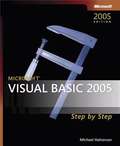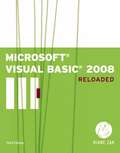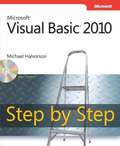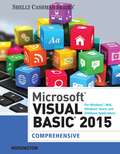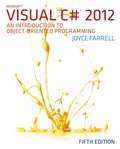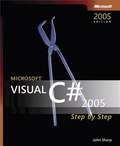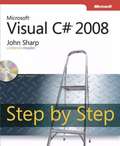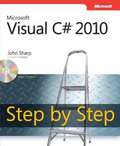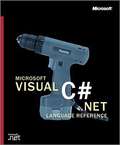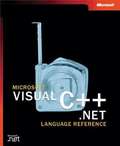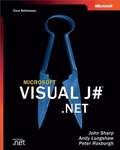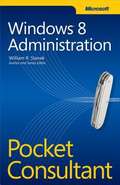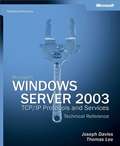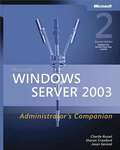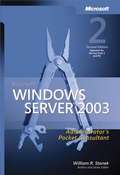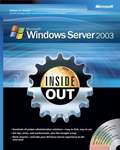- Table View
- List View
Microsoft® Visual Basic® .NET Programmer's Cookbook
by Matthew MacdonaldNext time you hit the wall with a tough Visual Basic .NET problem, get the code behind the solution--and solve it the right way. This PROGRAMMER'S COOKBOOK provides at-a-glance reference to hundreds of Visual Basic .NET programming scenarios using a concise, problem/solution format. The book's organized so you can quickly zero in on the topics and answers you need--with practical examples, code snippets, best practices, and undocumented secrets that get the job done. No half-baked solutions. Get expert code from expert developers. Get hundreds of recipes covering every application type--from Microsoft Windows to Web pages, Web services, remote components, and Windows services. Learn when to use lower-level Win32 APIs and COM components vs. the Microsoft .NET Framework Discover practical ways to deal with XML data and handle data binding with Microsoft ADO.NET. Build object-oriented components from scratch to access FTP sites, contact POP mail servers, and work with vectors, fractions, and complex numbers. Extend the reach of your Windows applications with WMI and use JavaScript to enhance Web pages. Tackle advanced techniques for multithreading, .NET Remoting, reflection, and cryptography. Uncover free third-party components to read zip files, write PDF documents, show menus in Microsoft ASP.NET, and more. Get all the book's code recipes on line.
Microsoft® Visual Basic® 2005 Express Edition: Build a Program Now!
by Patrice PellandBuild your own Web browser, desktop weather station, or other cool application--without any programming experience! Featuring learn-by-doing projects and plenty of visual examples, this hands-on book is your quick start to creating applications for Microsoft Windows. Have fun as you discover how to: Design a rich user interface with easy-to-use tools "Drag and drop" text boxes, buttons, and other controls into your application Add database and reporting capabilities Exploit features that reduce the amount of code you write Find and fix any bugs Roll-out and share your application CD Includes: Visual Basic 2005 Express Edition Microsoft SQL Server 2005 Express Edition A Note Regarding the CD or DVD The print version of this book ships with a CD or DVD. For those customers purchasing one of the digital formats in which this book is available, we are pleased to offer the CD/DVD content as a free download via O'Reilly Media's Digital Distribution services. To download this content, please visit O'Reilly's web site, search for the title of this book to find its catalog page, and click on the link below the cover image (Examples, Companion Content, or Practice Files). Note that while we provide as much of the media content as we are able via free download, we are sometimes limited by licensing restrictions. Please direct any questions or concerns to booktech@oreilly.com.
Microsoft® Visual Basic® 2005 Step by Step
by Michael HalvorsonWhether you are new to programming or to Visual Basic 2005, this tutorial gives you practical guidance to build your programming knowledge. Use the real-world exercises to teach yourself the essentials of Visual Basic--and begin creating applications for Microsoft Windows and the Web. Discover how to: Work in the Microsoft Visual Studio 2005 development environment Use Toolbox controls to create compelling user interfaces complete with digital photos, menus, toolbars, check boxes, and more Add artwork, animation, and special effects to an application Use inheritance and other new object-oriented programming capabilities Detect, track, and repair bugs in your code Store program data using variables, modules, arrays, and collections Add sophisticated functions to your applications with Microsoft .NET Framework 2.0 classes and methods Manage code flow with decision structures, loops, timers, and procedures Program interactive Web applications with Microsoft ASP.NET 2.0 Create datacentric applications using Microsoft ADO.NET Write custom code for printers and configure dialog boxes for printing Migrate Visual Basic 6.0 code to Visual Basic 2005 CD includes all practice exercises. A Note Regarding the CD or DVD The print version of this book ships with a CD or DVD. For those customers purchasing one of the digital formats in which this book is available, we are pleased to offer the CD/DVD content as a free download via O'Reilly Media's Digital Distribution services. To download this content, please visit O'Reilly's web site, search for the title of this book to find its catalog page, and click on the link below the cover image (Examples, Companion Content, or Practice Files). Note that while we provide as much of the media content as we are able via free download, we are sometimes limited by licensing restrictions. Please direct any questions or concerns to booktech@oreilly.com.
Microsoft® Visual Basic® 2008 Express Edition: Build a Program Now!
by Patrice PellandIn this lively, eye-opening, hands-on book, all you need is a computer and the desire to learn how to program with Visual Basic 2008 Express Edition. Featuring a full edition of the software, this fun and highly visual guide walks you through a complete programming project--a desktop weather-reporting application--from start to finish. You'll get an introduction to the Microsoft Visual Studio® development environment and learn how to put the lightweight, easy-to-use tools in Visual Basic Express Edition to work right away--creating, compiling, testing, and delivering your first ready-to-use program. You'll get expert tips, coaching, and visual examples at each step of the way, along with pointers to additional learning resources.
Microsoft® Visual Basic® 2008: Reloaded
by Diane ZakPairing fundamental programming concepts with fun, engaging game applications, Microsoft Visual Basic 2008: RELOADED, Third Edition provides a solid foundation in programming principles and how to use them. The book begins by covering the basics, like creating user interfaces, and understanding variables, constants, and calculations. Building upon this knowledge, coverage progresses to more advanced topics like creating classes and objects and using ADO.NET 2.0. This edition leverages the powerful pedagogy of previous editions, but brings it up-to-date with Visual Basic 2008.
Microsoft® Visual Basic® 2010 Developer's Handbook
by Klaus Löffelmann Sarika Calla PurohitYour expert guide to building modern applications with Visual Basic 2010 Take control of Visual Basic 2010--for everything from basic Windows® and web development to advanced multithreaded applications. Written by Visual Basic experts, this handbook provides an in-depth reference on language concepts and features, as well as scenario-based guidance for putting Visual Basic to work. It's ideal whether you're creating new applications with Visual Basic 2010 or upgrading projects built with an earlier version of the language. Discover how to: Use Visual Basic 2010 for Windows Forms and Windows Presentation Foundation projects Build robust code using object-oriented programming techniques, such as classes and types Work with events and delegates--and add your own events to custom classes Program arrays, collections, and other data structures in the Microsoft .NET Framework Solve problems quickly and easily using My namespace in Visual Basic Dive into Microsoft LINQ, including LINQ to XML and LINQ to Entities Tackle threading, multitasking, and multiprocessor development and debugging
Microsoft® Visual Basic® 2010 Step by Step
by Michael HalvorsonYour hands-on, step-by-step guide to learning Visual Basic® 2010. Teach yourself the essential tools and techniques for Visual Basic® 2010-one step at a time. No matter what your skill level, you'll find the practical guidance and examples you need to start building professional applications for Windows® and the Web. Discover how to:Work in the Microsoft® Visual Studio® 2010 Integrated Development Environment (IDE) Master essential techniques-from managing data and variables to using inheritance and dialog boxes Create professional-looking UIs; add visual effects and print support Build compelling Web features with the Visual Web Developer tool Use Microsoft® ADO.NET and advanced data presentation controls Debug your programs and handle run-time errors Use new features, such as Query Builder, and Microsoft® .NET Framework A Note Regarding the CD or DVD The print version of this book ships with a CD or DVD. For those customers purchasing one of the digital formats in which this book is available, we are pleased to offer the CD/DVD content as a free download via O'Reilly Media's Digital Distribution services. To download this content, please visit O'Reilly's web site, search for the title of this book to find its catalog page, and click on the link below the cover image (Examples, Companion Content, or Practice Files). Note that while we provide as much of the media content as we are able via free download, we are sometimes limited by licensing restrictions. Please direct any questions or concerns to booktech@oreilly.com.
Microsoft® Visual Basic® 2015 for Windows®, Web, Windows® Store, and Database Applications: Comprehensive
by Corinne HoisingtonNIMAC-sourced textbook
Microsoft® Visual C# 2012: An Introduction to Object-oriented Programming, Fifth Edition
by Joyce FarrellDevelop the strong programming skills in Visual C# you need for success with Farrell's MICROSOFT VISUAL C# 2012: AN INTRODUCTION TO OBJECT-ORIENTED PROGRAMMING, 5E. Engaging examples and a straightforward approach help readers establish solid skills in both structured and object-oriented programming, introducing critical principles and techniques that are easily transferrable to other programming languages. This edition incorporates the most recent versions of both C# and Microsoft Visual Studio 2012 with approachable "You Do It" sections, Video Lessons for each chapter, and a variety of new debugging exercises, programming exercises, and case studies to keep readers actively involved.
Microsoft® Visual C#® 2005 Express Edition: Build a Program Now!
by Patrice PellandBuild a software program--such as your own Web browser or weather-reporting application--without any programming experience! Featuring learn-by-doing projects and plenty of visual examples, this hands-on book is your quick start to creating applications for Microsoft Windows. Have fun as you discover how to: Design a rich user interface with easy-to-use tools "Drag and drop" text boxes, buttons, and other controls into your application Add database and reporting capabilities Exploit features that reduce the amount of code you write Find and fix any bugs Roll-out and share your application CD Includes: Visual C# 2005 Express Edition Microsoft SQL Server 2005 Express Edition A Note Regarding the CD or DVD The print version of this book ships with a CD or DVD. For those customers purchasing one of the digital formats in which this book is available, we are pleased to offer the CD/DVD content as a free download via O'Reilly Media's Digital Distribution services. To download this content, please visit O'Reilly's web site, search for the title of this book to find its catalog page, and click on the link below the cover image (Examples, Companion Content, or Practice Files). Note that while we provide as much of the media content as we are able via free download, we are sometimes limited by licensing restrictions. Please direct any questions or concerns to booktech@oreilly.com.
Microsoft® Visual C#® 2005 Step by Step
by John SharpTeach yourself Visual C# 2005 fundamentals--one step at a time. With this practical, learn-by-doing tutorial, you get the guidance you need to start creating programs and components in C#! Discover how to: Work in the Visual Studio 2005 development environment Declare variables, call methods, and create operators Construct statements to selectively or repeatedly run your code Catch and handle exception errors Use object-oriented concepts to declare classes and objects Write destructors to clean up unneeded code and help manage resources Create reusable components, such as properties, indexers, and events Define types and parameters for generics and generalized classes Use Windows Forms to create user interfaces complete with user controls Access data sources using Microsoft ADO.NET Construct Web Forms that display large volumes of data Validate user input with Microsoft ASP.NET controls Write, test, and deploy Web services CD features all practice exercises. A Note Regarding the CD or DVD The print version of this book ships with a CD or DVD. For those customers purchasing one of the digital formats in which this book is available, we are pleased to offer the CD/DVD content as a free download via O'Reilly Media's Digital Distribution services. To download this content, please visit O'Reilly's web site, search for the title of this book to find its catalog page, and click on the link below the cover image (Examples, Companion Content, or Practice Files). Note that while we provide as much of the media content as we are able via free download, we are sometimes limited by licensing restrictions. Please direct any questions or concerns to booktech@oreilly.com.
Microsoft® Visual C#® 2008 Express Edition: Build a Program Now!
by Patrice PellandIn this lively, eye-opening, hands-on book, all you need is a computer and the desire to learn how to program with Microsoft Visual C# 2008 Express Edition. Featuring a full edition of the software, this fun and highly visual guide walks you through a complete programming project--a desktop weather-reporting application--from start to finish. You'll get an introduction to the Microsoft Visual Studio® development environment and learn how to put the lightweight, easy-to-use tools in Visual C# Express Edition to work right away--creating, compiling, testing, and delivering your first ready-to-use program. You'll get expert tips, coaching, and visual examples at each step of the way, along with pointers to additional learning resources.
Microsoft® Visual C#® 2008 Step by Step
by John SharpGet the hands-on, step-by-step guide to learning the latest enhancements in Microsoft Visual C# 2008. Visual C#, one of the tools in Microsoft Visual Studio® 2008, is a modern programming language designed to deliver a productive environment for creating business frameworks and reusable object-oriented components. Whether you're a beginning programmer or new to the Visual C# programming language, you'll learn how to use the fundamental features of Visual Studio 2008 and gain a basic understanding of the latest enhancement of the Visual C# language. You'll work at your own pace through hands-on, learn-by-doing exercises, get started creating components and working Windows® applications, and build your knowledge as you start creating your first Visual C#-based applications. You'll also explore how to create data management and Web-based applications. In each chapter, work through learn-by-doing exercises that demonstrate how, when, and why to use the many features of the Visual C# rapid application development environment. Includes a companion CD with code samples, data sets, and a fully searchable eBook. A Note Regarding the CD or DVD The print version of this book ships with a CD or DVD. For those customers purchasing one of the digital formats in which this book is available, we are pleased to offer the CD/DVD content as a free download via OReilly Medias Digital Distribution services. To download this content, please visit OReillys web site, search for the title of this book to find its catalog page, and click on the link below the cover image (Examples, Companion Content, or Practice Files). Note that while we provide as much of the media content as we are able via free download, we are sometimes limited by licensing restrictions. Please direct any questions or concerns to booktech@oreilly.com.
Microsoft® Visual C#® 2010 Step by Step
by John SharpTeach yourself Visual C# 2010-one step at a time. Ideal for developers with fundamental programming skills, this practical tutorial features learn-by-doing exercises that demonstrate how, when, and why to use the features of the C# rapid application development environment. You'll learn how to use Microsoft Visual Studio® 2010 and Microsoft .NET Framework 4.0; develop a solid, fundamental understanding of C# language features; and then get to work creating actual components and working applications for the Windows® operating system. You'll also delve into data management technologies and Web-based applications.
Microsoft® Visual C#™ .NET Language Reference
by Microsoft CorporationHere's official documentation for the Microsoft® Visual C#® .NET language, including descriptions of all major features. This LANGUAGE REFERENCE is taken from Microsoft's electronic product documentation for Visual C# .NET. In its printed form, this material is portable, easy to use, and easy to browse--a comprehensive alternative to the substantial online help system in Visual C# .NET Standard software. Get the technical details you need to work with: Types Modifiers Statements Method parameters Namespaces Operator keywords Conversion keywords Access keywords Literal keywords XML documentation Attributes Preprocessor directives
Microsoft® Visual C++® .NET Language Reference
by Microsoft CorporationHere's official documentation for the Visual C++® .NET language, including descriptions of all major language elements. This LANGUAGE REFERENCE is taken from Microsoft's electronic product documentation for Visual C++ .NET. In its printed form, this material is portable, easy to use, and easy to browse--a comprehensive alternative to the substantial online help system in Visual C++ .NET. Get the technical details you need to work with: Keywords Modifiers Statements Operators Attributes Declarations Namespaces Abstract Declarators Initializers Classes, Structures, and Unions Managed Extensions Keywords Compiler Options Linker Options LINK Input and Output Files
Microsoft® Visual J#™ .NET (Core Reference)
by Andy Sharp John LongshawLeverage your Java skills and learn how to create powerful Windows® applications and high-performance, distributed applications with Microsoft® Visual J#® .NET in this comprehensive tutorial and reference. Presented in an easy-to-browse format, this erudite book provides the authoritative technical details you need to leverage Visual J# .NET and the richness of the Microsoft .NET Framework to build scalable, enterprise-level applications. You'll examine the architecture of .NET, find out how to process data with Visual J# .NET, see how to create XML Web services, and discover how to build multithreaded applications that span the local area network. You'll also look at the key topics for building applications that use Windows features and services and find out how to provide a global reach to your applications via the Internet. Topics covered include: The challenge of n-tier development The .NET platform Java and the common language runtime Graphical user interfaces Processing XML Transforming XML Microsoft ADO.NET Multithreading with .NET Basic network programming Serializing objects .NET remoting Using message queues Integrating with unmanaged components Serviced components and COM+ Writing Windows services Microsoft ASP.NET--a better ASP Building a Web service Creating a Web service client INCLUDES SAMPLE CODE ON THE WEB! Sample code available at the Companion Content link on this page
Microsoft® Visual Studio® Tips
by Sara FordUnlock the secrets of Visual Studio--learning hundreds of tips and shortcuts for optimizing the editor, search, navigation, windows layouts, and other capabilities. As a member of the Visual Studio Core Team, the author analyzed nearly every feature in the core environment--unearthing the tips and tweaks that streamline work and maximize efficiency. Get practical insights into how IDE features work, and how to quickly adapt them for any programming language. Accelerate your productivity with Sara's Top Six Tips--and hundreds more: Avoid accidentally copying blank lines Select only vertical columns of code Cycle through the clipboard to paste multiple elements Use incremental search to find what you are typing Increase your overall environment font size Use tracepoints to log the contents of a variable
Microsoft® Windows 8 Administration Pocket Consultant
by William R. Stanek<p>Portable and precise, this pocket-sized guide delivers ready answers for administering Windows 8. Zero in on core operations and tasks—and get the focused information you need to get the job done.</p>
Microsoft® Windows Server® 2003 TCP/IP Protocols and Services Technical Reference
by Joseph Davies Thomas LeeGet the in-depth technical details you need to support TCP/IP on the Windows® Server 2003 platform with this comprehensive technical guide. Combining concepts with packet examples, it steps layer by layer through the TCP/IP protocols and services that Windows Server 2003 supports to help you understand how they work and how they're implemented in the operating system. With the latest information about: Point-to-Point Protocol (PPP) Remote Authentication Dial-In User Service (RADIUS) Internet Protocol Security (IPSec) Virtual private networks (VPNs) A must-have for any technical professional who works with Windows Server 2003 and TCP/IP Includes details about these protocols and services: Network interface layer protocols: Local area network (LAN) and wide area network (WAN) encapsulations, Address Resolution Protocol (ARP), and PPP Internet layer protocols: Internet Protocol (IP) basics, addressing, and routing; Internet Control Message Protocol (ICMP); Internet Group Management Protocol (IGMP); and an overview of Internet Protocol version 6 (IPv6) Transport layer protocols: User Datagram Protocol (UDP), Transmission Control Protocol (TCP) basics, TCP connections, TCP data flow, and TCP retransmission, and time-out Application layer protocols and services: Dynamic Host Configuration Protocol (DHCP), Domain Name System (DNS), Windows Internet Name Service (WINS), file and printer sharing, RADIUS and Internet Authentication Service (IAS), Microsoft® Internet Information Services (IIS) and the Internet protocols, IPSec, and VPNs.Winner of a Merit Award at the Puget Sound Chapter of the Society for Technical Communication (STC), January 2004). A Note Regarding the CD or DVD The print version of this book ships with a CD or DVD. For those customers purchasing one of the digital formats in which this book is available, we are pleased to offer the CD/DVD content as a free download via O'Reilly Media's Digital Distribution services. To download this content, please visit O'Reilly's web site, search for the title of this book to find its catalog page, and click on the link below the cover image (Examples, Companion Content, or Practice Files). Note that while we provide as much of the media content as we are able via free download, we are sometimes limited by licensing restrictions. Please direct any questions or concerns to booktech@oreilly.com.
Microsoft® Windows Server® 2012 Administration
by Matthew Hester Chris HenleyFast, accurate answers for common Windows Server questions Serving as a perfect companion to all Windows Server books, this reference provides you with quick and easily searchable solutions to day-to-day challenges of Microsoft's newest version of Windows Server. Using helpful design features such as thumb tabs, tables of contents, and special heading treatments, this resource boasts a smooth and seamless approach to finding information. Plus, quick-reference tables and lists provide additional on-the-spot answers. Covers such key topics as server roles and functionality, user and group maintenance, directory management and replication, and backup and recovery Addresses automating administrative tasks and managing server remote access Helps you with disk management and storage, folder security, and performance tuning Walks you through common troubleshooting issues as well as maintaining and controlling the centralized desktop Microsoft Windows Server 2012 Administration Instant Reference is a must-have resource for finding quick answers quickly!
Microsoft® Windows Server™ 2003 Administrator's Companion
by Sharon Crawford Charlie Russel Jason GerendGet your mission-critical systems up and running quickly with this essential, single-volume guide to administering Windows Server 2003--fully updated for Service Pack 1 and R2. This comprehensive administrator's reference details operating system features and capabilities, and provides easy-to-follow procedures, practical workarounds, and key troubleshooting tactics for on-the-job-results. Discover how to: Create a deployment roadmap and complete an upgrade or a new installation NEW--Implement customized server scripts to help automate administration tasks UPDATED--Learn tools and techniques for installing and configuring Active Directory UPDATED--Manage TCP/IP-based networks, including DHCP, DNS, and WINS servers UPDATED--Configure and support Network Load Balancing clusters and server clusters NEW--Set up a wireless network that helps meet your security requirements NEW--Extend interoperability with legacy systems, including UNIX and Linux NEW--Deploy and configure Microsoft Internet Security and Acceleration Server 2004 Monitor, tune, maintain, and repair your system CD features: Scripts that you can adapt to your own work Scriptomatic 2.0 scripting tool Windows Script Host (WSH) 5.6 Help files Microsoft OLE Viewer administration and testing tool Fully searchable eBook A Note Regarding the CD or DVD The print version of this book ships with a CD or DVD. For those customers purchasing one of the digital formats in which this book is available, we are pleased to offer the CD/DVD content as a free download via O'Reilly Media's Digital Distribution services. To download this content, please visit O'Reilly's web site, search for the title of this book to find its catalog page, and click on the link below the cover image (Examples, Companion Content, or Practice Files). Note that while we provide as much of the media content as we are able via free download, we are sometimes limited by licensing restrictions. Please direct any questions or concerns to booktech@oreilly.com.
Microsoft® Windows Server™ 2003 Administrator's Pocket Consultant
by William R. StanekPortable and precise, this pocket-sized guide delivers immediate answers for the day-to-day administration of Windows Server 2003. Zero in on core support and maintenance tasks using quick-reference tables, instructions, and lists. You'll get the focused, straightforward information you need to solve problems and get the job done?whether you're at your desk or in the field! Get fast facts to: Manage and troubleshoot servers and workstations Administer Active Directory and manage computers, domain controllers, and organizational units Create user accounts and group accounts--and control rights and permissions Manage file systems, directories, drives, volume sets, and RAID Combat malware and use file screening to block unauthorized content Install, configure, and test TCP/IP networking Set up and optimize DHCP, WINS, and DNS Manage shadow copies, revert volumes, and help improve disk quota management Troubleshoot local printers and network print servers Monitor network activity and tune network performance
Microsoft® Windows Server™ 2003 Administrator’s Pocket Consultant, Second Edition
by William Stanek<div xmlns="http://www.w3.org/1999/xhtml"><p>Your fast-answers, pocked-sized guide to the Microsoft Windows Server 2003 operating system, featuring quick-reference tables, lists, and step-by-step instructions.</p></div>
Microsoft® Windows Server™ 2003 Inside Out
by William R. StanekDig in--and discover how to put the reliability, scalability, and security enhancements in Windows Server 2003 to work! This supremely organized reference packs all the details you need to plan and manage a Windows Server 2003 implementation and handle everyday administration. You'll gain hundreds of timesaving solutions, troubleshooting tips, and workarounds, along with more than 100 tools and scripts on CD. Find the best and fastest ways to perform everyday system administration tasks, and challenge yourself to new levels of Windows Server mastery! Plan, prepare, and install Windows Server 2003 interactively or remotely Identify clear upgrade and migration paths, including incremental adoptions Design, manage, and maintain Active Directory sites, domains, and forests Manage storage, file systems, network resources, and print services Plan for and implement high availability with clustering and load balancing Set up and troubleshoot TCP/IP networking, DHCP, WINS, and DNS Configure security settings and manage critical updates and service packs Exploit command-line tools and scripts for simple to sophisticated tasks Perform backups and restoration and tune performance Get "insider secrets" and exclusive tips from the author! CD features: Complete eBook in PDF format Windows Server 2003 Resource Kit Tools--100+ tools and scripts for managing Active Directory operations, group policy, TCP/IP networks, the registry, security features, and more Extensive catalog of resources--with links to Internet Information Services (IIS) 6.0 Resource Kit tools, File Replication Services (FRS) tools, Management Pack tools for Microsoft Operations Manager, Microsoft Baseline Security Analyzer 1.2, and more Microsoft Systems Architecture 2.0 documentation--enterprise-class architectural blueprints and implementation guidance Insider Extras--including documentation on FRS, Emergency Management Services, certificates, and clustering A Note Regarding the CD or DVD The print version of this book ships with a CD or DVD. For those customers purchasing one of the digital formats in which this book is available, we are pleased to offer the CD/DVD content as a free download via O'Reilly Media's Digital Distribution services. To download this content, please visit O'Reilly's web site, search for the title of this book to find its catalog page, and click on the link below the cover image (Examples, Companion Content, or Practice Files). Note that while we provide as much of the media content as we are able via free download, we are sometimes limited by licensing restrictions. Please direct any questions or concerns to booktech@oreilly.com.


